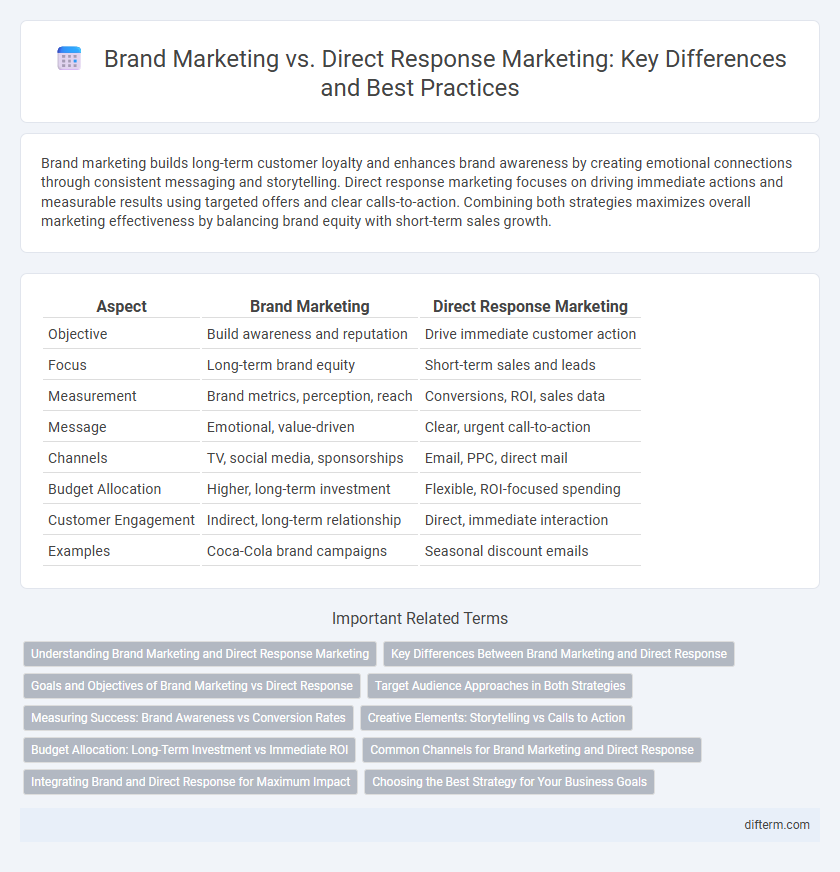Brand marketing builds long-term customer loyalty and enhances brand awareness by creating emotional connections through consistent messaging and storytelling. Direct response marketing focuses on driving immediate actions and measurable results using targeted offers and clear calls-to-action. Combining both strategies maximizes overall marketing effectiveness by balancing brand equity with short-term sales growth.
Table of Comparison
| Aspect | Brand Marketing | Direct Response Marketing |
|---|---|---|
| Objective | Build awareness and reputation | Drive immediate customer action |
| Focus | Long-term brand equity | Short-term sales and leads |
| Measurement | Brand metrics, perception, reach | Conversions, ROI, sales data |
| Message | Emotional, value-driven | Clear, urgent call-to-action |
| Channels | TV, social media, sponsorships | Email, PPC, direct mail |
| Budget Allocation | Higher, long-term investment | Flexible, ROI-focused spending |
| Customer Engagement | Indirect, long-term relationship | Direct, immediate interaction |
| Examples | Coca-Cola brand campaigns | Seasonal discount emails |
Understanding Brand Marketing and Direct Response Marketing
Brand marketing focuses on building long-term customer loyalty and increasing overall brand awareness by creating emotional connections and consistent messaging across multiple channels. Direct response marketing aims to generate immediate sales or actions through targeted campaigns with clear calls-to-action and measurable results. Integrating both strategies optimizes marketing effectiveness by balancing brand equity growth with direct revenue generation.
Key Differences Between Brand Marketing and Direct Response
Brand marketing focuses on building long-term customer relationships by enhancing brand awareness, loyalty, and perception through emotional and consistent messaging, whereas direct response marketing aims for immediate actions like clicks, leads, or sales with measurable, time-sensitive campaigns. Key differences include the primary goal--brand marketing prioritizes reputation and recognition while direct response marketing emphasizes conversion rates and return on investment (ROI). Metrics differ significantly, with brand marketing measuring brand equity and engagement, and direct response marketing tracking specific response metrics such as cost per acquisition (CPA) and click-through rates (CTR).
Goals and Objectives of Brand Marketing vs Direct Response
Brand marketing aims to build long-term brand equity by fostering customer loyalty and enhancing brand awareness through emotional connections and consistent messaging. Direct response marketing focuses on driving immediate actions such as sales, leads, or sign-ups by using clear calls-to-action and measurable campaigns. While brand marketing targets broad audience engagement and perception, direct response marketing prioritizes quantifiable results and quick ROI.
Target Audience Approaches in Both Strategies
Brand marketing centers on building long-term relationships by appealing to the emotions and identity of a broad target audience, emphasizing brand loyalty and recognition. Direct response marketing targets specific consumer segments with clear, immediate calls to action, aiming for measurable, short-term conversions. Effective marketing strategies often combine both by engaging diverse audience profiles through tailored messaging and precise targeting techniques.
Measuring Success: Brand Awareness vs Conversion Rates
Brand marketing success is measured by metrics like brand awareness, recall, and customer engagement, reflecting long-term brand equity growth. Direct response marketing focuses on conversion rates, tracking immediate actions such as clicks, sign-ups, and sales to evaluate campaign effectiveness. Understanding these distinct measurement frameworks helps marketers allocate resources strategically for sustained growth and immediate return on investment.
Creative Elements: Storytelling vs Calls to Action
Brand marketing leverages creative storytelling to build emotional connections and long-term loyalty by delivering narratives that resonate with a target audience's values and aspirations. Direct response marketing uses clear, compelling calls to action designed to prompt immediate consumer responses, often measured through clicks, sign-ups, or purchases. Effective marketing strategies balance storytelling to establish brand identity with actionable prompts that drive measurable results.
Budget Allocation: Long-Term Investment vs Immediate ROI
Brand marketing emphasizes budget allocation as a long-term investment aimed at building brand equity and customer loyalty over time, often requiring consistent funding to maintain visibility and perception. Direct response marketing focuses on immediate ROI by allocating budget toward campaigns designed to generate quick, measurable actions such as sales, leads, or clicks. Balancing these strategies requires marketers to distribute budgets strategically, ensuring sustained brand growth while capturing short-term revenue opportunities.
Common Channels for Brand Marketing and Direct Response
Brand marketing primarily leverages channels such as social media platforms, television, radio, and offline events to build long-term customer relationships and enhance brand awareness. Direct response marketing focuses on channels like email marketing, pay-per-click (PPC) advertising, search engine marketing (SEM), and direct mail to drive immediate consumer actions and measure ROI effectively. Both strategies utilize digital marketing tools but differ in their approach to audience engagement and conversion tracking.
Integrating Brand and Direct Response for Maximum Impact
Integrating brand marketing with direct response marketing amplifies customer engagement by combining long-term brand loyalty with immediate actionable results. Brand marketing builds emotional connections and trust, while direct response provides measurable outcomes through targeted campaigns and clear calls-to-action. Leveraging data analytics to synchronize these strategies enhances overall marketing ROI and drives sustainable growth.
Choosing the Best Strategy for Your Business Goals
Brand marketing cultivates long-term customer loyalty and enhances overall brand perception by emphasizing emotional connections and consistent messaging. Direct response marketing drives immediate actions, such as sales or sign-ups, through targeted campaigns and clear calls to action that provide measurable ROI. Selecting the optimal strategy depends on business goals: prioritize brand marketing for awareness and trust building, while direct response marketing suits performance-based objectives and rapid conversions.
Brand marketing vs direct response marketing Infographic

 difterm.com
difterm.com